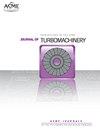基于全粘性离散伴随谐波平衡法的多目标气动和气动弹性耦合设计优化
IF 3.1
3区 工程技术
Q3 ENGINEERING, MECHANICAL
引用次数: 0
摘要
随着对高载荷、高效率涡轮机的要求越来越高,叶片越来越薄,因此,考虑气动性能和气动弹性稳定性的设计优化变得越来越必要。在本研究中,使用算法微分(AD)开发了一个全粘性离散伴随谐波平衡(HB)求解器,并通过基于对偶性质的离散线性求解器进行了验证,然后用于进行多学科耦合设计优化。为此,开发了一个多目标伴随设计优化框架,以提高涡轮机械叶片的气动性能和气动弹性稳定性。该框架分为气动弹性设计初始化和气动Pareto前沿确定两个步骤。首先,对叶片型面进行优化,仅提高气动弹性稳定性,并限制气动性能的变化。第二,将第一步优化后的叶型作为初始叶型,然后利用气动参数的目标函数和气动弹性参数的约束条件进行进一步优化。通过将优化结果与单目标气动和气动弹性耦合设计优化方法的优化结果进行比较,验证了多目标优化设计方法的有效性。NASA旋翼67在假设振动模式下的跨音速试验结果表明,多目标耦合设计优化方法能够提高两个学科的性能。本文章由计算机程序翻译,如有差异,请以英文原文为准。
Multi-objective aerodynamic and aeroelastic coupled design optimization using a full viscosity discrete adjoint harmonic balance method
With increasing requirements for high-loading and high-efficiency turbomachines, blades become thinner and thinner and thus design optimizations considering both aerodynamic performances and aeroelastic stability become more and more necessary. In this study, a full viscosity discrete adjoint harmonic balance (HB) solver has been developed using algorithmic differentiation (AD), verified by a discrete linear solver based upon duality property, and then adopted to perform multi-disciplinary coupled design optimizations. To this end, a framework of multi-objective adjoint design optimizations has been developed to improve both aerodynamic performances and aeroelastic stability of turbomachinery blades. This framework is divided into two steps of the aeroelastic design initialization and aerodynamic Pareto front determination. First, the blade profiles are optimized to improve the aeroelastic stability only and constrain the variations of aerodynamic performances. Second, the optimized blade profiles in the first step are used as the initial ones and then further optimized with the objective function of aerodynamic parameters and the constraints of aeroelastic parameters. The effectiveness of the multi-objective design optimization method is demonstrated by comparing the optimization results with those from the single-objective aerodynamic and aeroelastic coupled design optimization method. The results from transonic NASA Rotor 67 subjected to a hypothetic vibration mode show that the multi-objective coupled design optimization method is capable of improving performances in both disciplines.
求助全文
通过发布文献求助,成功后即可免费获取论文全文。
去求助
来源期刊
CiteScore
4.70
自引率
11.80%
发文量
168
审稿时长
9 months
期刊介绍:
The Journal of Turbomachinery publishes archival-quality, peer-reviewed technical papers that advance the state-of-the-art of turbomachinery technology related to gas turbine engines. The broad scope of the subject matter includes the fluid dynamics, heat transfer, and aeromechanics technology associated with the design, analysis, modeling, testing, and performance of turbomachinery. Emphasis is placed on gas-path technologies associated with axial compressors, centrifugal compressors, and turbines.
Topics: Aerodynamic design, analysis, and test of compressor and turbine blading; Compressor stall, surge, and operability issues; Heat transfer phenomena and film cooling design, analysis, and testing in turbines; Aeromechanical instabilities; Computational fluid dynamics (CFD) applied to turbomachinery, boundary layer development, measurement techniques, and cavity and leaking flows.

 求助内容:
求助内容: 应助结果提醒方式:
应助结果提醒方式:


